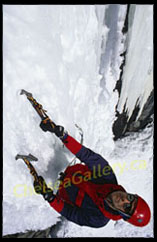Exposed! :: Warm Photos from Winter's Cold ::© Copyright 2007. All Rights Reserved. Contents
Every fall I beg and I plead - I ask my students to come prepared for the cool weather photography of eastern North America. Some students do not understand what that means. Often someone gets cold and, slowly, their attention turns from apertures and composition to cold toes and chattering teeth! One of the best photography skills you can learn is how to stay warm. This is crucial to creating beautiful photos in winter! In this edition of Exposed! I offer some guidelines to keep clicking in the cold. Cold weather presents one obvious challenge for photographers - staying warm! I once had the opportunity to meet Doug Scott, one of the world's most accomplished mountaineers. He told me summiting the world's highest peaks is as much about hard climbing skills as it is about good self-care - staying hydrated, staying healthy, and staying warm. If your body cannot perform you will not get good results. It is the same with photography - if you have freezing cold hands it is not likely your mind will be on fine picture taking. I have discovered many ways to stay comfortable on my own adventures. Try them and make adjustments appropriate for your specific metabolism and body. Cold Comfort Tips - Your CoreYour torso and head are the vital areas of your body - they hold all your important parts - brain, heart, liver, etc. Your body is conditioned to keep the vital organs warm at all costs - even at the risk of your extremities. It is no coincidence your toes and fingers first feel the cold!
To keep your hands and feet warm you must keep your core well insulated! Wear many layers of wool, fleece, polyester, and nylon but leave the cotton at home! Cotton does not have the same insulating features as these other material and will actually keep you cold. Your outer layer should be windproof, but breathable - a warm parka is a good option. On your head put a hat or two... or three. Use your hood. Wear a scarf! Warm FeetA Sorel type winter boot and warm socks are excellent investments. However, one sure way to get cold feet is to wear socks and boots that are too warm! Too warm?! Yes. Your feet will sweat. The insulation will get wet and, then, your feet will get COLD! Make sure boots and socks are thoroughly dry before using them. Using a vapour barrier liner (VBL) will help. A VBL? - it is a fancy phrase for a plastic bag. Put one bag between a liner sock and thick sock for each foot. Your foot will sweat and feel damp but the boot and sock insulation will stay dry and keep your feet warm! If you use this method take care of your feet with foot powder, etc, to prevent skin problems - think ‘diaper rash' - on your feet. Toasty HandsCold hands can be overcome! If you are already keeping your core properly insulated you are half way to warm hands. Try a liner glove or x-country ski glove to handle your camera. Wear a big warm mitt over top when waiting for the action! And, of course, take extra care handling camera equipment with gloves or mitts. AdjustmentsYou want to wear enough to be very warm while standing still at cold temperatures. However, too warm and you will perspire and THEN get cold because you are damp. Adjust your clothes for different activities - walking to your photo location and then standing still for the photo action to appear. On a photo expedition in the winter avoid sweating at all costs! If you do feel sweaty stop and adjust your clothing or slow your physical activity. FuelHave ample carbohydrates before a winter photo safari - this is not a time to be watching your waist line! Also, make sure you are well hydrated with frequent, small drinks. Hydrating properly is an ongoing task that can help maximize your blood volume. Proper blood volume keeps your body working efficiently and comfortably - and that means proper warmth! Peeing too frequently could be an indication you are drinking too much, too quickly! Listen to your body. Ask your doctor if you have questions or concerns! Pro PerspectiveAs I am walking, skiing or climbing to my winter shooting spot - such as the ice climbing shoot (above right) near Wakefield, Quebec - I wear size 'L' for 'large'' clothes. However, once I get to the location - where I will be stationary for some time - I start pulling on the insulation finishing with my XXL outer shell. I have so many clothes on I cover three size ranges! I will not win a fashion show but I will be toasty warm. More importantly, my attention will be on producing my fine photos. When I approach my photo location I carry two very important bags - one full of camera equipment and the other full of the extra clothes. And what kind of camera do I use in the cold? As low-tech as possible - the more electronic power the camera consumes, the quicker it will hibernate (ie stop working) at 20 below! Keeping your camera clicking in the cold is a subject for a future Exposed! (Subscribe to receive Exposed! automatically - see the top of the page) HomeworkEasy. This winter experiment with how you dress for photo adventures. Remember:
Final FrameYes, there is a lot of maintenance to ensure warmth in winter's cold. If you are warm, though, your photos will glow! Take photos. Stay warm. Have fun! Like the article? Digg it and spread the word! |
Samples |

